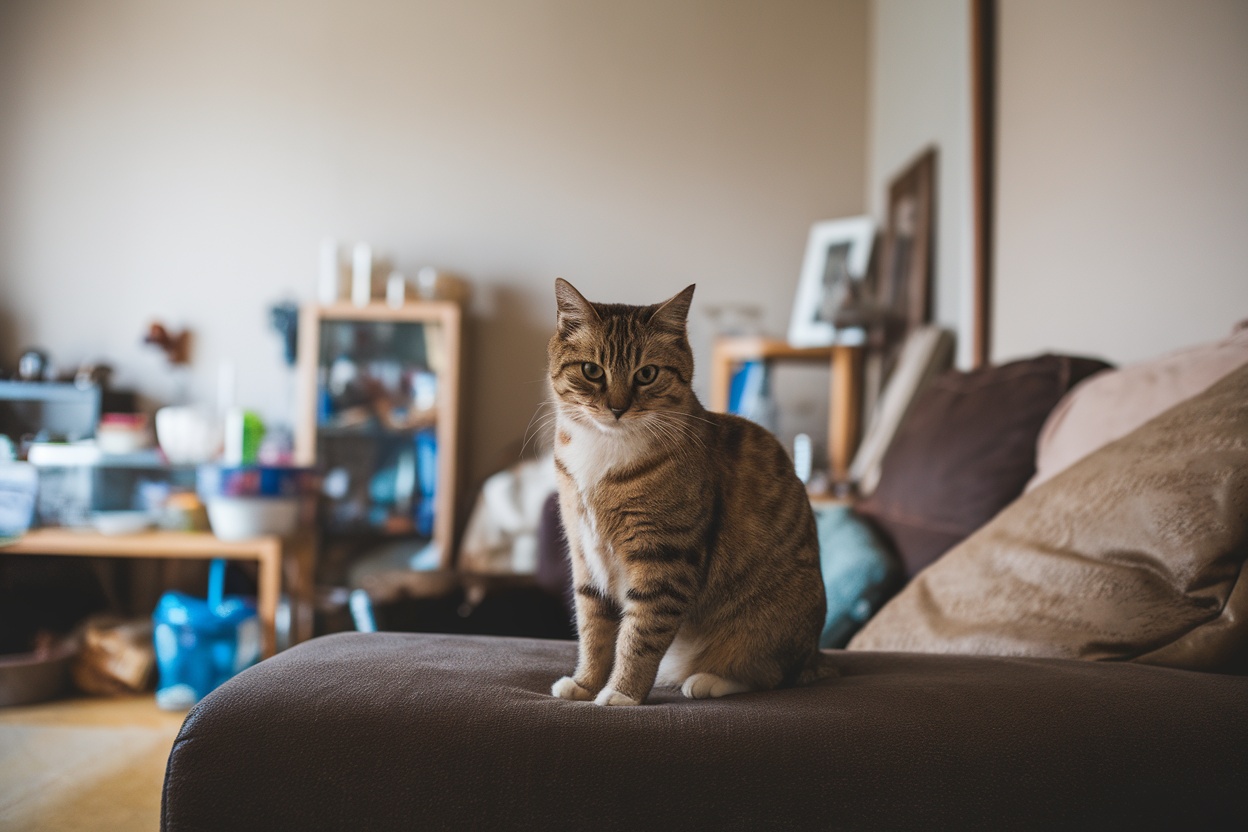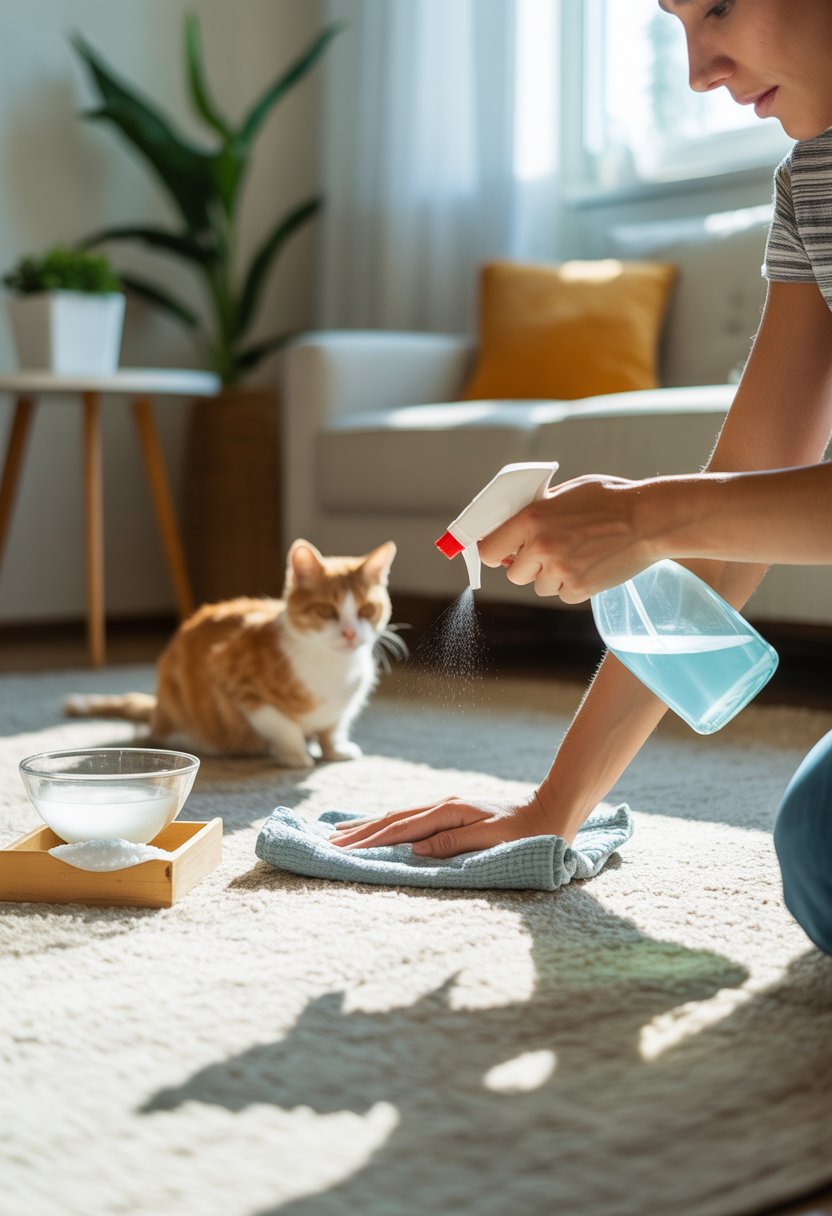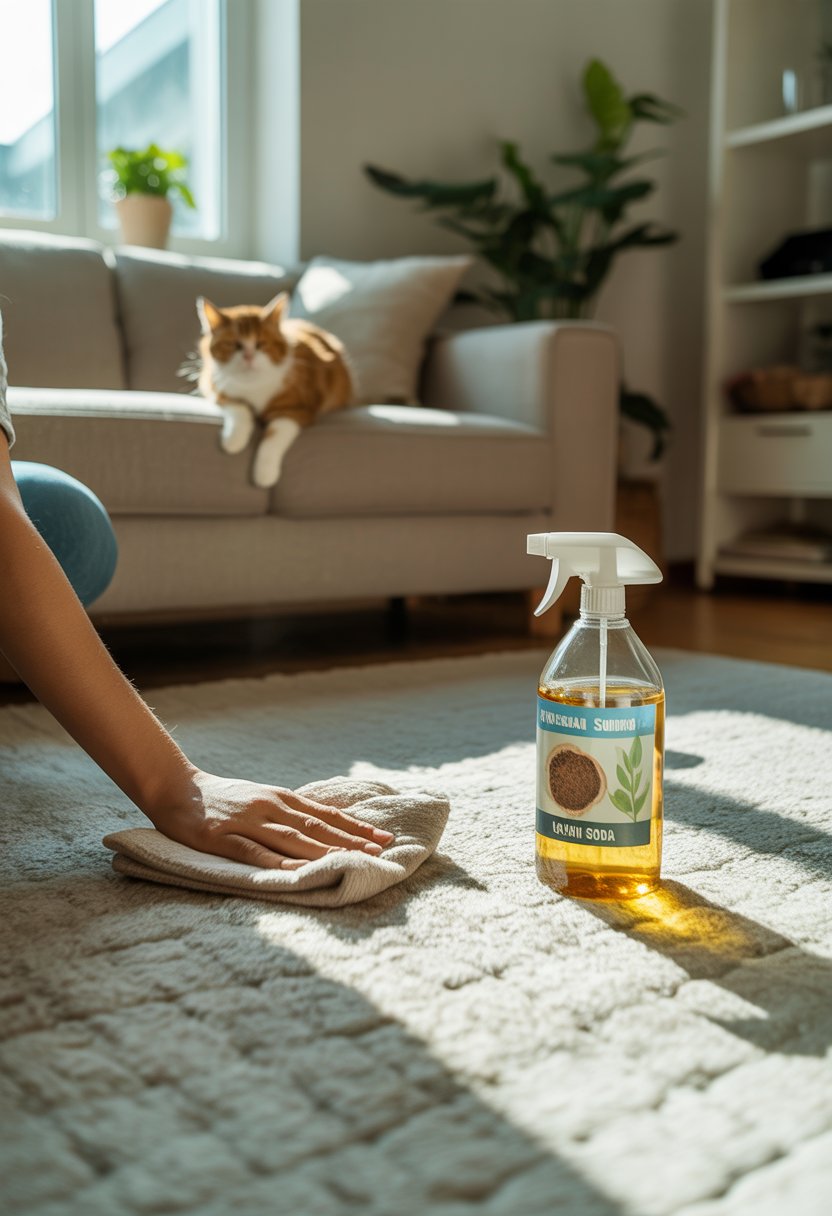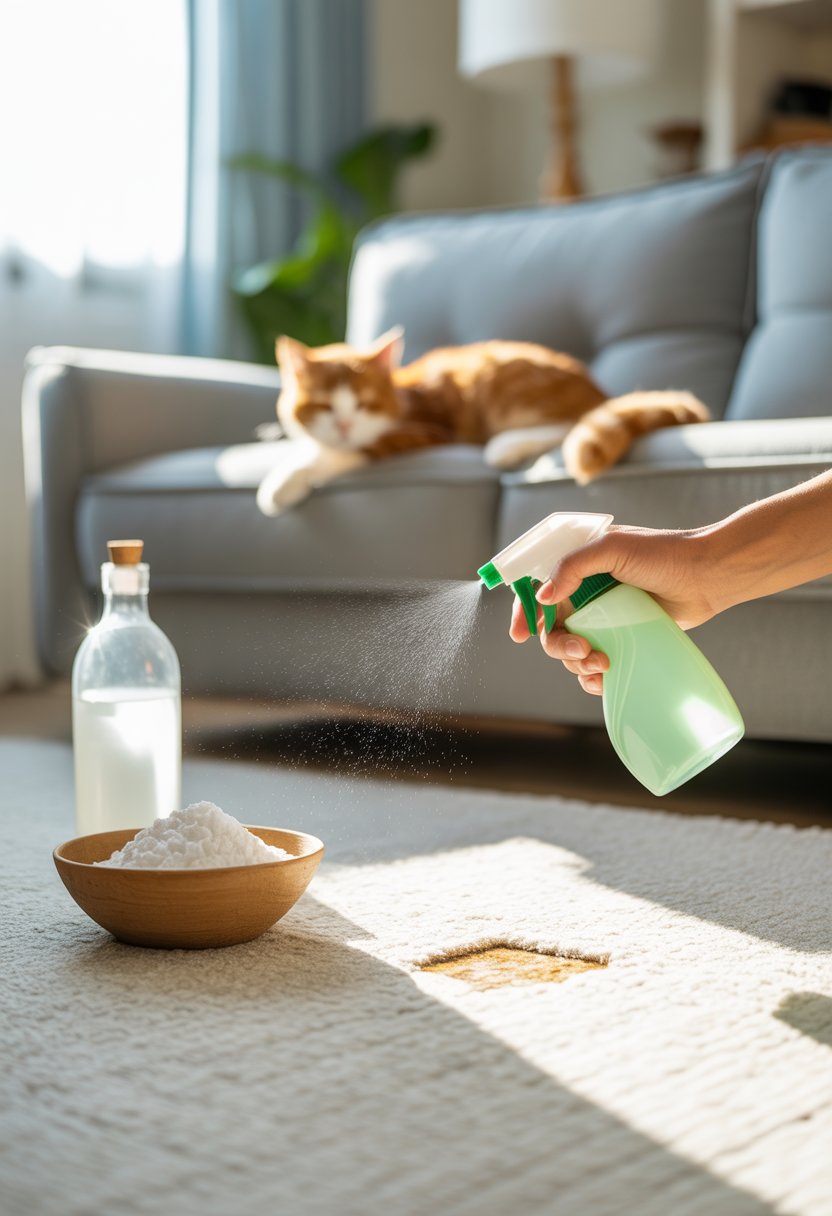
Cat pee odor can really turn your home into an uncomfortable place, both for you and anyone who visits. That sharp ammonia smell just loves to linger, no matter how many times you scrub.

You can actually eliminate cat pee odor from your home with simple stuff like white vinegar, baking soda, and enzyme cleaners. These methods break down the compounds behind the stink instead of just covering it up.
This guide digs into why cat urine is so stubborn and lays out what to do for fresh accidents. You’ll get techniques for different surfaces and tips for finding sneaky spots that might be fueling that never-ending smell.
Why Cat Pee Odor Is So Difficult to Remove
Cat urine has some weird chemical compounds that really bond with surfaces and keep producing odor over time. When you use regular cleaners, you often just end up spreading those compounds around.
Understanding Urine Chemistry
Cat urine is made up of three main parts that create its strong smell. Urea breaks down into ammonia, and that’s the sharp scent you immediately notice.
Urochrome gives urine its yellow color. It doesn’t stink much, but at least it tells you where the cat struck.
Uric acid is the real troublemaker. It forms crystals that cling stubbornly to surfaces and just won’t dissolve in water. Every time they get wet, the smell pops right back up.
Those uric acid crystals can hang around in your carpet, wood, or fabric for months. Humidity or water reactivates them and—yep, you guessed it—here comes the stink again.
Male cats, especially unneutered ones, create stronger-smelling urine. Their pee is packed with extra proteins and hormones, so it’s a bit of a nightmare.
Persistent Causes of Odor
Uric acid crystals dig deep into things like carpet padding and wood subfloors. Surface cleaning barely scratches the surface (literally).
Warmth makes the odor even worse. Hot weather or heating vents can kick those smell molecules right into the air.
Moisture is another enemy. Humidity, steam cleaning, or even a spill can make old pee spots flare up again.
Bacteria love to chow down on urine compounds, and they create even more bad smells. They thrive in warm, damp places—so yeah, it’s a vicious cycle.
Cats often return to the same spot, layering new stains on top of old ones. The more they do it, the tougher the odor gets.
Why Conventional Cleaners Fail
Most household cleaners rely on water. Water can’t dissolve uric acid crystals, so you just end up moving them around.
Soap-based cleaners leave a residue that attracts dirt—and sometimes, it just makes the odor worse. Soap films trap bacteria and moisture.
Bleach and ammonia-based products? They actually smell a lot like cat urine. Your cat might think, “Hey, this is a good spot,” and go right there again.
Steam cleaners often push urine deeper into carpet padding and subfloors. The heat just helps spread the smell around your home.
Air fresheners and deodorizers? They mask odors for a bit, but don’t actually solve anything.
Immediate Steps to Tackle Fresh Cat Pee
If you act fast when you find fresh cat urine, you can stop the smell from sinking deep and make cleanup way easier. With the right blotting technique and some basic cleaners, most odors are no big deal if you jump on them within a few hours.
Blotting and Absorbing Urine
Slip on some disposable gloves to keep your hands clean. Grab a stack of paper towels or old rags you don’t mind tossing.
Don’t rub or scrub—seriously. That just shoves the mess deeper into the carpet or wood. Press the towels down firmly, then lift straight up.
Swap out soaked towels for dry ones and keep blotting until nothing comes up. For big spots, you might use a dozen or more towels.
If you’re dealing with carpet, stack up some towels and stand on them for half a minute. That helps soak up pee that’s gone deeper.
On hard floors, mop up every bit of liquid. Don’t forget to check cracks between tiles or floorboards—urine loves to hide there.
First-Line Home Cleaning Solutions
Mix equal parts white vinegar and water in a spray bottle. Spray it all over the area and let it sit for five minutes.
Blot up the vinegar solution with fresh towels. Vinegar neutralizes ammonia and helps break down the stink.
For carpets: After the vinegar, sprinkle baking soda on the damp area. Leave it overnight, then vacuum it up in the morning.
For hard surfaces: Wipe with the vinegar mix, rinse with plain water, and dry well.
You can swap in dish soap and water if you want. Use a tablespoon of dish soap per cup of warm water. Apply, let it sit for five minutes, then blot dry.
Safety Tips for Handling Messes
Always wear gloves when cleaning up cat pee. Cat waste can carry toxoplasmosis and other nasties that sneak in through tiny cuts.
Don’t mix cleaning products. Bleach plus ammonia makes toxic gas—just don’t go there. Stick to one cleaning method at a time.
Open windows and crank a fan while you clean. Fresh air helps clear out fumes and odors.
Keep your pets and kids away from the area until it’s totally dry. Some cleaners can irritate skin or paws.
Wash your hands really well after cleaning—even if you wore gloves. Throw all used towels, gloves, and rags into a sealed garbage bag.
Proven Simple Remedies to Neutralize Cat Odor
Three household staples can really help with cat urine odors. Baking soda soaks up moisture and neutralizes acids, while vinegar breaks down those stubborn uric acid crystals.
Using Baking Soda for Odor Control
Baking soda acts as a natural deodorizer, soaking up moisture and neutralizing acids from cat pee. You can use it on carpets, furniture, and hard floors.
For fresh messes:
- Blot up as much liquid as you can
- Sprinkle baking soda all over the spot
- Wait 15–30 minutes
- Vacuum thoroughly
For old, set-in smells:
- Mix 1/2 cup baking soda with 1 cup warm water
- Apply to the area
- Let it dry for a few hours
- Vacuum up the residue
Sprinkle a little baking soda in problem areas every few days to help prevent future marking.
Vinegar Solutions for Deep Cleaning
White vinegar dissolves uric acid crystals—the real source of lingering cat odor. Mix equal parts white vinegar and water in a spray bottle for most cleaning jobs.
How to use:
- Spray the area thoroughly
- Wait 10–15 minutes
- Blot with a clean cloth
- Rinse with plain water
- Let it air dry
For tough stains, go with straight vinegar. Let it sit for 30 minutes before blotting.
The vinegar smell fades as it dries, so don’t worry. Never combine vinegar with bleach or other chemicals.
Hydrogen Peroxide Alternatives
Hydrogen peroxide (3% solution) can break down organic stuff in cat urine. Test it on a hidden spot first—it can bleach some fabrics.
Basic cleaner:
- 1/4 cup hydrogen peroxide
- 1 teaspoon dish soap
- 1 tablespoon baking soda
Apply to stains, wait 15 minutes, then blot and rinse with water.
For carpets, spray hydrogen peroxide directly on the stain. Cover with a damp cloth and leave for half an hour. The fizzing action helps lift odors from deep down.
Use fresh hydrogen peroxide for best results. Keep it in a dark bottle so it doesn’t break down.
Targeting Odor in Carpets, Upholstery, and Hard Floors

Different surfaces call for different cleaning moves. Carpets need enzyme cleaners, while hard floors usually respond to vinegar solutions.
Cleaning Carpets with Home Remedies
Blot up fresh urine right away with paper towels—press down hard, but don’t rub. Rubbing just drives the pee deeper.
Mix equal parts vinegar and water in a spray bottle, then spray the spot generously. Let it sit for five minutes so the vinegar can do its thing.
Sprinkle baking soda on the damp area to soak up moisture and odors. Leaving it overnight works best.
For tough odors, try this enzyme mix:
- 1 cup hydrogen peroxide (3%)
- 1 teaspoon dish soap
- 2 tablespoons baking soda
Mix and apply to the stain. Wait ten minutes, then blot. Vacuum when dry.
Restoring Upholstery and Soft Surfaces
Take off cushion covers and wash them cold with enzyme detergent. Add a cup of vinegar to the rinse, then air dry completely.
For upholstery that can’t be removed, blot first. Mix 2 tablespoons laundry detergent with 1 cup cold water. Dab with a clean cloth, blotting over and over.
Make a finishing spray with equal parts vodka and water. Vodka kills odor-causing bacteria—just spritz lightly and let it air dry.
Always test cleaners on a hidden spot first. Some fabrics react badly or shrink.
Steam cleaning can help with deep odors in upholstery. Renting a small steamer is worth it if nothing else works.
Cleaning Hardwood and Tile Floors
Wipe up fresh urine right away with paper towels. Mop the spot with a damp mop before it seeps into wood or grout.
Mix 1 cup white vinegar with a gallon of warm water. Mop the area to break down crystals and chase away odors.
This solution is safe for sealed hardwood. For unsealed wood, go easy on the vinegar to avoid damage.
For grout:
- Make a paste with baking soda and water
- Scrub grout lines with an old toothbrush
- Rinse and dry
Hydrogen peroxide works on light-colored grout. Pour 3% peroxide on the stain, let it bubble for two minutes, then scrub and rinse.
Preventing Recurrence and Odor Re-Mark

If you want to stop future accidents, you need to make treated areas less appealing to cats and keep any lingering odors at bay. A little daily cleaning goes a long way in keeping your home fresh and stopping that cycle of re-marking.
Deterring Repeat Accidents
Cats love returning to familiar spots. They can still smell traces of old accidents, even after a thorough cleaning.
Even if you scrub and scrub, tiny urine particles can stick around in carpet padding or seep into wood subflooring. It’s maddening.
Try laying down some aluminum foil or double-sided tape on those cleaned areas. Most cats can’t stand the feel and will steer clear. Keep these deterrents there for a couple of weeks—maybe three if you’re feeling patient.
If your cat’s especially stubborn, motion-activated deterrents might be worth a shot. Set up a battery-powered air sprayer near the problem zone. The quick puff of air usually sends cats running—nothing harmful, just a little surprise.
Try switching up the area’s purpose for a while. Put food and water bowls right where the accidents happened. Most cats avoid peeing where they eat, so it’s a handy trick.
Block off those sneaky spots under furniture or behind appliances. Shove some storage boxes or use furniture blockers so your cat can’t squeeze in.
Effective Odor Blockers
Enzyme cleaners break down urine compounds, but honestly, they don’t always reach deep enough. After cleaning, slap on some odor-blocking primer to the subfloor or any wall surfaces that got hit.
Shellac-based primers are a lifesaver. They seal in smells for good. Use them on wood floors, baseboards, or drywall. Two thin coats, and make sure each one dries all the way.
For carpets, sprinkle baking soda on the treated area. Leave it overnight, then vacuum it up. If you’re dealing with stubborn odors, repeat this weekly for a month.
An air purifier with activated carbon does wonders in rooms where accidents happened. Let it run non-stop for about a month to clear out any lingering stink.
Sometimes, the only fix is to replace the carpet padding. Once urine soaks into that stuff, it’s almost impossible to get the smell out.
Routine Cleaning Schedules
Scoop out the litter box every day. Cats can be picky, and a dirty box might make them look for alternatives.
Change all the litter every week or so—7 to 10 days is a good rule of thumb.
Vacuum carpets and rugs twice a week with a HEPA filter. Focus on your cat’s favorite hangouts. Empty the vacuum bag right after each session.
Weekly deep cleaning routine:
- Mop hard floors with enzyme cleaner
- Wash pet bedding in hot water
Wipe down baseboards and walls, too. Check for new accidents with a blacklight.
Steam clean carpets once a month using a pet-safe cleaner. The heat can help activate any leftover enzymes and pull out deep odors.
Keep an eye on your cat’s bathroom habits. If you notice changes in frequency or location, address them early—it’s easier to fix small issues than big ones.
Addressing Lingering Smells and Hidden Spots

Cat urine has a way of hiding where you’d least expect, and the smell can sneak back even after you’ve cleaned. Black lights make dried urine stains visible, and enzyme cleaners break down those stubborn odor compounds that regular soap and water just can’t touch.
Finding Invisible Cat Pee
A UV black light is your best friend for hunting down hidden cat pee. Turn off all the lights and slowly scan the room. Cat urine glows a weird yellow-green under UV, so it’s hard to miss.
Check out these common hiding spots:
- Carpet padding under stains
- Wooden subfloors beneath carpets
- Baseboards and wall corners
- Curtains and fabric furniture
- Mattresses and box springs
Mark each spot you find with chalk or tape so you don’t forget where to clean.
Some older stains won’t light up much. Trust your nose—get close to suspicious spots and sniff around. Not glamorous, but it works.
Dealing With Persistent Odors
Enzyme cleaners are your go-to for stubborn cat pee smells. These cleaners have bacteria that actually eat away the uric acid crystals in cat urine. Regular cleaners can’t do that.
Soak the affected area with enzyme cleaner. Make sure it gets everywhere the urine did. Wait 15-20 minutes, then blot it dry.
For carpet stains that just won’t quit, pull back the carpet and treat the padding and subfloor directly.
White vinegar can help, too:
- Mix equal parts white vinegar and water
- Spray on the area after you’ve used the enzyme cleaner
- Let it air dry
Skip ammonia-based cleaners. They smell way too much like cat pee and might just invite more trouble.
Ventilation and Air Purification
Letting in fresh air can really help get rid of stubborn smells around the house. If the weather’s nice, just crack open some windows or doors.
Try flipping on ceiling fans to keep the air moving. It really does make a difference.
Air purifiers with activated carbon filters actually grab odor molecules out of the air. Pop a purifier into the room where the mess happened, and just let it run for a few days after you’ve cleaned up.
Baking soda is a classic for a reason—it soaks up funky smells. Sprinkle some on your carpets, leave it overnight, then vacuum it up in the morning. You can even stash open boxes of baking soda in the corners of smelly rooms.
If you’ve got a heating or cooling system, swap in HEPA air filters. Honestly, if pets are involved, you’ll probably want to change those filters more often than usual.
A dehumidifier can also help in damp spots. Humidity seems to make smells stick around forever, doesn’t it?

